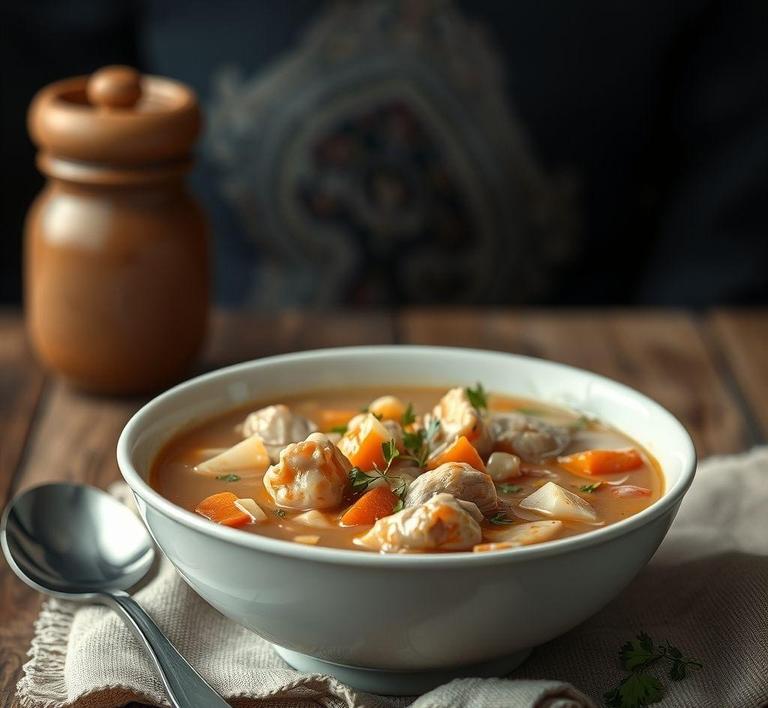If you’ve found yourself with leftover turkey soup after a big holiday feast or a cozy dinner, you might be wondering whether it’s safe to refreeze it for later. Refreezing turkey soup can be a practical way to extend its shelf life, but there are a few things to keep in mind to ensure that your soup maintains its flavor and texture. Whether you’re looking to save some time on future meals or simply want to avoid food waste, this guide will walk you through the best practices for safely refreezing turkey soup, including tips on how to store it and what to watch out for when reheating. So, let’s dive in and make sure your leftovers stay just as tasty as when they were first made!
Can You Refreeze Turkey Soup?

Refreezing turkey soup is a common question that often arises after preparing a large batch for a holiday meal or when there are leftovers after a family dinner. The general answer is yes, you can refreeze turkey soup, but with some important considerations. The key to successfully refreezing turkey soup without compromising its safety or quality lies in the handling and storage techniques.
When it comes to the safety of refreezing, the USDA recommends that food should only be refrozen if it has been safely thawed in the refrigerator and hasn’t been out of the "danger zone" (40°F to 140°F) for more than two hours. If the turkey soup was left out at room temperature for longer than that, refreezing could lead to foodborne illness, as bacteria may have had time to multiply.
In terms of texture and flavor, turkey soup is one of those dishes that can handle freezing quite well, though some ingredients may be more sensitive to the freezing process. If done correctly, the soup can be refrozen and reheated without any major negative effects, especially if the soup consists mostly of broth, vegetables, and turkey meat. However, things like creamy bases or dairy-based ingredients (such as cream or milk) may not fare as well when refrozen.
How To Refreeze Turkey Soup?
To refreeze turkey soup without compromising safety or quality, follow these steps carefully:
1. Cool The Soup Quickly
The first step in successfully refreezing turkey soup is ensuring that it cools rapidly before being placed in the freezer. The goal is to bring the temperature of the soup down to a safe level (below 40°F) as quickly as possible to prevent bacterial growth. You can speed up this process by:
- Dividing the soup into smaller portions: Smaller containers cool faster than one large pot.
- Using an ice bath: If you’re in a rush, you can place the pot in a sink filled with ice water, making sure that water doesn’t touch the soup itself.
- Stirring occasionally: Stirring the soup helps release heat and speeds up the cooling process.
2. Store The Soup In An Airtight Container
Once the soup has cooled completely, it’s time to transfer it to containers for freezing. Use airtight containers or freezer-safe resealable bags. Be sure to leave a little space at the top of each container to allow for expansion as the soup freezes. If using bags, lay them flat in the freezer for easy storage.
Tip: Label the containers with the date the soup was cooked or frozen, so you can keep track of how long it’s been stored.
3. Freeze The Soup
Place the soup in the coldest part of the freezer. It is advisable to freeze the soup within two hours of cooling it to prevent bacterial contamination. If you’re freezing turkey soup in multiple portions, you’ll have the option to take out just what you need later, without having to refreeze large amounts multiple times.
4. Thaw And Reheat Properly
When you’re ready to eat the turkey soup again, thaw it in the refrigerator rather than at room temperature. This ensures that the soup stays out of the danger zone. It can take anywhere from several hours to overnight for the soup to thaw properly in the fridge, depending on the size of the portion.
When reheating, make sure that the soup is brought to a rolling boil for a few minutes to ensure that it is thoroughly heated and safe to eat.
Quality Impact
Refreezing turkey soup does impact the quality of the soup, although the extent depends on the ingredients and how the soup was originally prepared. Here are some factors to keep in mind:
1. Texture Of Vegetables
Vegetables in turkey soup, particularly those that are high in water content like celery, zucchini, and tomatoes, may become mushy when refrozen. The freezing process breaks down their cell walls, causing them to lose their firmness when thawed and reheated. If you want to preserve the texture of the vegetables, consider removing them before freezing and adding fresh vegetables when reheating.
2. Broth And Flavor
The broth of the soup, however, usually freezes and refreezes well. When thawed and reheated, the soup should still retain its rich flavor, provided it was made with a quality stock or broth to begin with. However, it’s important to note that the longer you freeze and refreeze, the more the flavor may change slightly, losing some of the initial brightness. Seasonings such as herbs or spices may become a little less distinct, and the soup may need to be adjusted upon reheating.
3. Dairy-based Soups
If your turkey soup contains dairy (like cream or milk), you might notice that the texture could suffer after refreezing. Dairy tends to separate or curdle when frozen, making the soup appear grainy or watery once reheated. To mitigate this, you can consider freezing the broth and turkey separately from the cream and adding fresh dairy when reheating the soup.
4. Turkey Meat
Turkey meat, being lean, generally holds up well to freezing and refreezing. However, there is always a slight chance that it may dry out a little after being frozen. It’s usually best to use moist cooking methods to keep the meat tender, such as slow-cooking, when initially preparing the soup.
While the prospect of refreezing turkey soup may raise concerns about safety and quality, it is entirely feasible as long as proper steps are followed. The most important thing is to cool the soup quickly, store it in airtight containers, and ensure that it is properly reheated. The quality impact is usually more noticeable in the texture of certain ingredients, like vegetables and dairy, but overall, turkey soup can still be a delicious and convenient meal after it has been refrozen. By following the recommended practices for freezing, storing, and reheating, you can extend the life of your turkey soup without sacrificing much in flavor or safety.
Is It Safe To Refreeze Turkey Soup?
When it comes to food safety, especially with soups, the general rule of thumb is that refreezing can be a bit of a gray area. Refreezing turkey soup, in particular, is something that requires a bit more attention due to the ingredients involved.
Turkey soup, like most cooked dishes, can be refrozen, but there are several factors to consider to ensure it remains safe to eat. The primary concern when refreezing any food, including turkey soup, is the safety of handling and the temperature fluctuations it undergoes. If the soup has been thawed properly (in the refrigerator, not at room temperature), and has not been left out for longer than 2 hours at any point, it should be safe to refreeze. However, it’s important to note that the quality of the soup may degrade each time it is frozen and thawed. So while refreezing turkey soup is technically safe, the texture and flavor might suffer with every cycle.
A critical part of the process is the initial freezing. To preserve the flavor and texture of your turkey soup, it should be cooled rapidly and frozen in small, airtight containers. Doing this ensures that the soup freezes quickly and evenly, limiting the potential for bacterial growth. If you do plan to refreeze, ensure that the soup is still cold when you put it back in the freezer, ideally no warmer than 40°F (4°C).
Key Takeaway: Refreezing turkey soup can be safe if done under proper conditions, but it’s important to be mindful of the texture and quality after multiple freezing and thawing cycles.
Signs That Turkey Soup Should Not Be Refrozen
There are several red flags that can indicate whether your turkey soup has been compromised and should not be refrozen. Here are some common signs to look out for:
- Smell: One of the first indicators that your turkey soup is no longer safe to refreeze is an unpleasant odor. A sour or off smell is often a sign that bacteria have begun to multiply, and the soup has spoiled. If the aroma is different from its usual savory turkey scent, it’s time to discard the soup.
- Discoloration: Changes in color can also suggest that the soup has gone bad. If the broth looks murky, greasy, or has a strange hue, it could mean that the ingredients have started to break down in an unsafe way. This is particularly concerning when dealing with poultry, as turkey is highly susceptible to bacterial contamination when mishandled.
- Texture Changes: After the initial freezing and thawing, the texture of the soup may be affected. If the turkey meat appears mushy or disintegrates when stirred, or if the broth has separated into layers, it could be a sign that the soup should not be refrozen. Additionally, if any of the ingredients in the soup-such as vegetables or noodles-appear limp or mushy, they may no longer be safe to consume.
- Time and Temperature Abuse: If the soup has been left out at room temperature for more than 2 hours (or 1 hour if the room is particularly warm), bacteria can multiply quickly. Even if the soup looks fine, it’s no longer safe to freeze or refreeze it. The risk of foodborne illness increases exponentially when food is left at unsafe temperatures for extended periods.
Key Takeaway: Always check the smell, texture, and appearance of your turkey soup before deciding to refreeze it. If any signs of spoilage are present, discard it to avoid foodborne illnesses.
Common Refreezing Mistakes
When attempting to refreeze turkey soup, many people make a few common mistakes that can compromise the safety and quality of the dish. Here are the most frequent errors to avoid:
- Refreezing Soup That Has Been Left Out Too Long: One of the biggest mistakes is refreezing soup that has been left at room temperature for an extended period. Bacteria multiply rapidly at temperatures between 40°F and 140°F (4°C to 60°C), so if your soup has been sitting out for more than 2 hours, it should be discarded, not refrozen. Even if it looks and smells fine, it’s risky to consume.
- Thawing Soup at Room Temperature: When thawing soup, the best method is to place it in the refrigerator, where it can thaw gradually and safely. Thawing soup on the counter can lead to uneven cooling, which creates an environment where bacteria can thrive. Avoid leaving the soup to thaw at room temperature for more than a few hours.
- Refreezing After Multiple Thaws: Each time turkey soup is thawed and refrozen, the quality diminishes. The texture becomes grainy, and the flavor can degrade due to the breakdown of proteins and fat. Refreezing soup after multiple cycles not only reduces quality but also increases the likelihood of bacterial growth. For best results, try to freeze turkey soup only once and consume it within a reasonable time.
- Not Cooling the Soup Properly Before Freezing: It’s tempting to throw warm soup straight into the freezer, but this can cause the freezer temperature to rise, which can affect the other foods inside and increase the risk of bacterial contamination. Always let your soup cool down to room temperature before freezing, and if possible, split it into smaller portions to allow for faster and more even cooling.
Key Takeaway: The best way to refreeze turkey soup safely is by avoiding these common mistakes, ensuring it is properly cooled, and ensuring the soup has been stored and handled according to safety guidelines.
Tips And Tricks
To ensure the best quality and safety when refreezing turkey soup, here are some helpful tips and tricks:
- Cool Soup Quickly: If you plan to freeze turkey soup, cool it down rapidly after cooking. Use an ice bath or divide the soup into smaller portions to help it cool faster. This prevents bacteria growth during the cooling process and makes sure that the soup freezes faster, which helps preserve its texture.
- Use Airtight Containers: Always store turkey soup in airtight containers or freezer bags. Not only does this prevent freezer burn, but it also helps retain the soup’s flavor and texture. Label the containers with the date, so you know how long the soup has been stored and can consume it before it deteriorates.
- Portion Control: To avoid thawing more soup than you need, portion the soup into smaller containers when you freeze it. This way, you can take out just the amount you need and avoid refreezing the leftovers multiple times.
- Thaw Soup Properly: Thaw turkey soup in the refrigerator or by reheating it on the stove or in the microwave. Do not leave it on the counter to thaw, as this can encourage bacterial growth.
- Avoid Refreezing After Thawing: If you’ve already thawed turkey soup and decided not to eat it, it’s best to avoid refreezing it a second time. If you’re unsure, consider cooking the soup again, which might help reduce some of the risk, though it will still affect the texture and flavor.
Key Takeaway: By using proper techniques for cooling, storing, and thawing, you can preserve the quality and safety of your turkey soup, making it more enjoyable when reheated.
Conclusion
Refreezing turkey soup is possible and can be done safely, but there are crucial steps to follow to avoid foodborne illnesses and to maintain the quality of the soup. The safety of refreezing depends largely on how the soup has been handled, including how it was cooled, how long it was left out, and whether it was stored in an airtight container. Signs of spoilage-like an off smell, strange texture, or discoloration-should always be your first clue that it’s not safe to refreeze.
To maximize safety and maintain the best taste, avoid common mistakes like leaving soup out too long, refreezing after multiple thawing cycles, and using improper containers. With a little extra care and attention, you can enjoy your turkey soup after it’s been frozen and even refrozen, but always keep in mind that each freezing and thawing cycle impacts the flavor and texture.
When in doubt, use your senses to determine whether the soup is still good, and follow best practices for storage, handling, and thawing. Properly freezing turkey soup once and consuming it within a reasonable time ensures that you get the most out of your leftovers, without sacrificing taste or safety.


